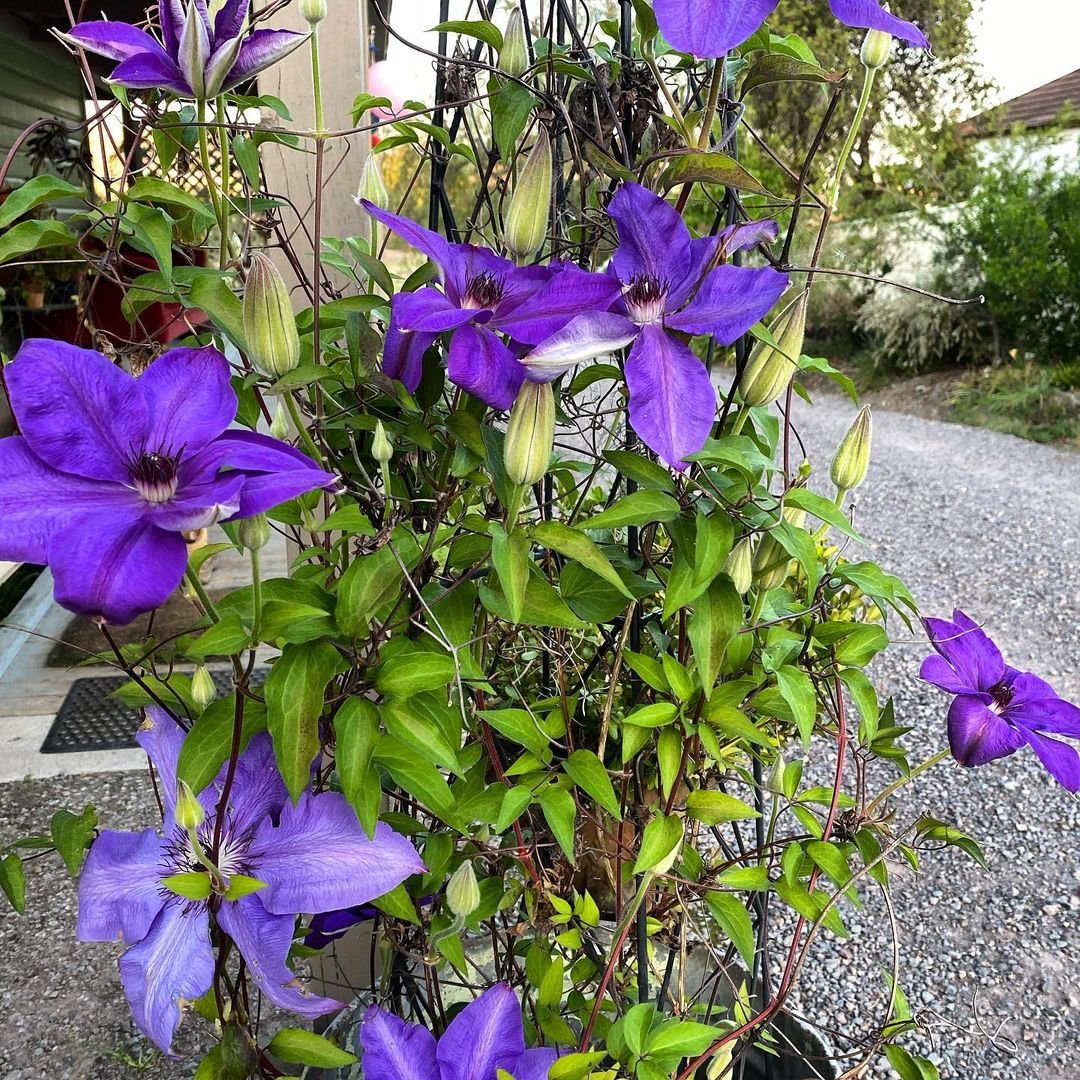Get answers to your top questions about Clematis Jackmanii. This comprehensive FAQ guide covers all aspects of growing, caring for and enjoying this beautiful climbing vine in your garden.
Clematis Jackmanii is a popular climbing vine known for its large, vibrant purple flowers. It’s a deciduous perennial that belongs to the buttercup family (Ranunculaceae). This variety was first introduced in 1862 and has since become a favorite among gardeners for its stunning blooms and vigorous growth.
Here is a chart with detailed information on Clematis ‘Jackmanii’:
| Category | Information |
|---|---|
| Botanical Name | Clematis ‘Jackmanii’ |
| Common Name | Clematis ‘Jackmanii’ |
| Plant Type | Deciduous Perennial Climber |
| Hardiness Zone | 4-9 |
| Sun Exposure | Full Sun to Partial Shade |
| Soil Type | Well-drained, Moist, Fertile Soil |
| Watering | Regular, Keep Soil Consistently Moist |
| Growth Habit | Climbing, Twining |
| Height/Spread | 8-12 feet tall / 3-6 feet wide |
| Flowering Time | Summer (Usually June to September) |
| Flower Description | Large, Velvety Deep Purple Flowers, 4-6 inches wide |
| Special Features | Long Blooming Period, Attracts Pollinators (Bees, Butterflies), Low Maintenance, Ideal for Trellises, Arbors and Fences |
How tall does Clematis Jackmanii grow?

Clematis Jackmanii can grow up to 10-12 feet (3-3.7 meters) tall with a spread of 3-6 feet (0.9-1.8 meters). Its vigorous growth makes it ideal for covering trellises, fences or walls.
When does Clematis Jackmanii bloom?
This clematis typically blooms from mid-summer to early fall, usually from July to September. It produces an abundance of large, velvety purple flowers that can reach 5-7 inches (12-18 cm) in diameter.
Is Clematis Jackmanii easy to grow?
Yes, Clematis Jackmanii is considered relatively easy to grow, making it a good choice for both novice and experienced gardeners. However, it does require proper care and attention to thrive.
What kind of soil does Clematis Jackmanii prefer?
Clematis Jackmanii prefers well-draining, fertile soil. It grows best in soil with a pH between 6.0 and 7.0. Adding organic matter to the soil can improve its fertility and drainage.
How much sunlight does Clematis Jackmanii need?
This clematis variety prefers full sun to partial shade. It generally needs at least 6 hours of direct sunlight daily for optimal blooming. However, in hotter climates, some afternoon shade can be beneficial.
How often should I water Clematis Jackmanii?
Water your Clematis Jackmanii regularly, especially during its first growing season. The soil should be kept consistently moist but not waterlogged. Once established, it’s somewhat drought-tolerant but still benefits from regular watering during dry spells.
Does Clematis Jackmanii need fertilizer?
Yes, Clematis Jackmanii benefits from regular fertilization. Apply a balanced, slow-release fertilizer in early spring and again in mid-summer. Avoid over-fertilizing, as this can lead to excessive foliage growth at the expense of flowers.
How do I prune Clematis Jackmanii?
Clematis Jackmanii belongs to pruning group 3, which means it should be pruned in late winter or early spring before new growth begins. Cut all stems back to about 12-18 inches (30-45 cm) from the ground. This encourages vigorous new growth and abundant blooming.
Can Clematis Jackmanii be grown in containers?
Yes, Clematis Jackmanii can be grown in containers, provided the pot is large enough (at least 18 inches/45 cm deep) and has good drainage. Use a high-quality potting mix and ensure the plant has proper support for climbing.
Is Clematis Jackmanii deer resistant?
Clematis Jackmanii is generally considered deer resistant, but no plant is completely deer-proof. In areas with high deer populations, young plants may need protection until they’re established.
How do I support Clematis Jackmanii?
Provide sturdy support such as a trellis, fence or arbor for your Clematis Jackmanii to climb. You can also use twine or garden wire to guide the vines as they grow. Ensure the support structure is in place before or soon after planting.
What are common pests and diseases that affect Clematis Jackmanii?
Common issues include:
- Clematis wilt
- Powdery mildew
- Aphids
- Spider mites
Regular inspection and proper care can help prevent or manage these problems.
How long does it take for Clematis Jackmanii to establish?
Clematis Jackmanii typically takes 2-3 years to fully establish. During this time, it’s crucial to provide proper care, including regular watering, fertilization and support for climbing.
Can Clematis Jackmanii be propagated?
Yes, Clematis Jackmanii can be propagated through layering or by taking softwood cuttings in late spring or early summer. However, it’s important to note that propagated plants may not be identical to the parent plant due to potential genetic variations.
Is Clematis Jackmanii toxic?
All parts of Clematis Jackmanii are considered toxic if ingested, containing irritant glycosides. It’s best to keep pets and children from eating any part of the plant. If ingestion occurs, seek medical advice immediately.
How do I prepare Clematis Jackmanii for winter?
In colder regions (USDA zones 4-5), provide winter protection by mulching the base of the plant with a thick layer of organic material. In container gardens, move pots to a sheltered location or wrap them to protect the roots from freezing.
Can Clematis Jackmanii be grown as a ground cover?
While Clematis Jackmanii is primarily a climbing vine, it can be allowed to sprawl as a ground cover in certain landscape designs. However, it performs best and produces more flowers when grown vertically.
How do I encourage more blooms on my Clematis Jackmanii?
To promote more blooms:
- Ensure adequate sunlight
- Fertilize appropriately
- Water consistently
- Prune correctly (in late winter/early spring)
- Provide proper support for climbing
What companion plants work well with Clematis Jackmanii?
Good companions include:
- Roses (for complementary colors and growth habits)
- Hostas (for contrasting foliage)
- Ornamental grasses (for texture contrast)
- Other clematis varieties (for extended blooming seasons)
How do I deadhead Clematis Jackmanii?
Deadheading isn’t necessary for Clematis Jackmanii, as it doesn’t significantly affect blooming. However, you can remove spent flowers for a tidier appearance if desired.
Clematis Jackmanii is a beautiful and rewarding addition to any garden. With its stunning purple blooms and vigorous growth, it can quickly become a focal point in your landscape. By following the care tips outlined in this FAQ guide, you can ensure your Clematis Jackmanii thrives and provides years of beautiful flowers.
Remember that every garden is unique, so you may need to adjust your care routine based on your specific climate and growing conditions. Don’t be afraid to experiment and learn as you go – that’s part of the joy of gardening!
For more gardening tips and plant care guides, visit https://usagardenweb.com/








Leave a Reply